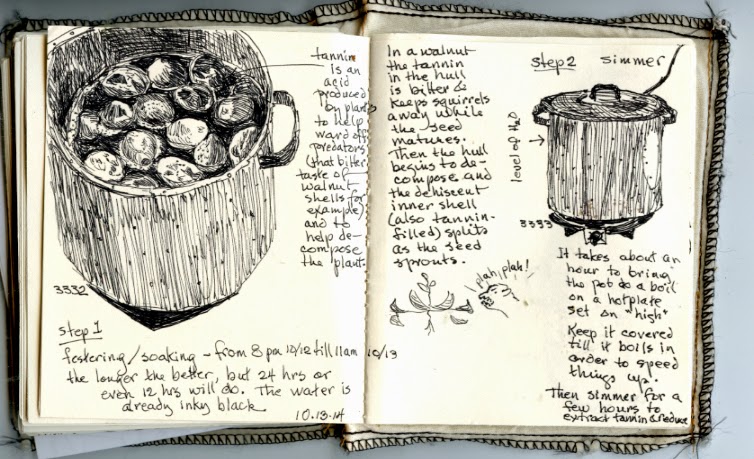This was the easiest and best walnut ink batch I've ever made. If you're interested in making your own, read the directions written on each of these three pages. If you have any questions, ask them, and I'll do my best to answer. As you can see, this is not only not rocket science, but it's also not even elementary school science either! No measuring, infinite variations, lots of options. You can stop in the middle of simmering, turn everything off, and start again when you have more time. Actually, you can stop anywhere you want for a pause, and the pause can last hours or even days. If things start to get a little stinky, just throw in a little acetic acid (vinegar) or rubbing or denatured alcohol. If the extraction of tannin seems to be taking too long, dump in about a half cup of baking soda to speed things up.

One time when I made walnut ink with a class we forgot it on the stove and the water all evaporated. When I found it just in time to avert a fire, the pot was full of burnt walnut hull remains. I didn't have time to start over so I simply added water to the carbonized stuff and simmered it for a little while. The resulting ink was lovely, blacker than usual, silky and smooth. (But I would NOT advise going off and leaving your pot on a stove without setting a timer in the room where you can hear it.)
This is a yummy batch. A fine mesh filter is necessary because there are lots of small particles that need to come out.[]
'''''''''''''['
]]]]]]]]]]]]]]]] (Jesse's comment) I use a plastic coffee filter that is flat on the bottom. I bought mine in the grocery store. You can see it in drawing 3335. If you can't find this kind of filter, you could also strain the ink through two layers of old pantyhose stretched over the mouth of a jar.
I also researched tannin. As I suspected, tannin in plants functions as a protection from predators as well as an aid to decomposition (without which a seed could not get out of the protective hull and have a chance of sprouting). I've made oak gall ink with galls gathered from gall oak trees in parts of Italy and southern France. The tannin in the galls must protect the wasp eggs within the gall and then help the gall decompose so the little insects can escape. Tannin is acidic; hence the bitter taste if you accidentally get a piece of walnut shell in your mouth.




thank you, gwen!
ReplyDeleteok, so i started long ago with boiling my black walnuts and making dye in a stockpot, that sat on my back porch YEARS ago, and has since frozen and thawed, been added to, and subtracted from, used as ink, etc. i added more walnuts two years ago, it has been soaking since then. i use it occasionally, but i honestly don't know how colorfast it is... but it is dark and rich and not at all stinky anymore.
ReplyDeleteA true stock pot of walnut ink, Velma! I'm sure it just gets better and better! If the colorfastness of the black tannin that won't ever come out of your clothing or off of your hands is any indication, I would think the ink is probably colorfast!
Delete